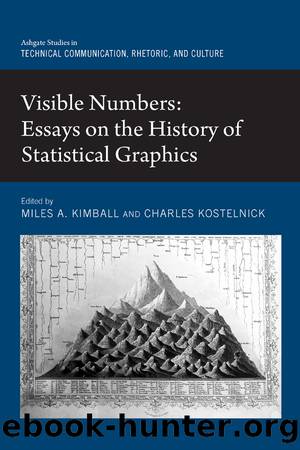Visible Numbers: Essays on the History of Statistical Graphics by Miles A. Kimball and Charles Kostelnick

Author:Miles A. Kimball and Charles Kostelnick
Language: eng
Format: epub
Publisher: Routledge
Figure 6.7
Comparative View of the Principal Rivers in the Four Quarters of the World, published by the Society for Promoting Christian Knowledge (1832)
Figure 6.8
Table accompanying Comparative View of the Principal Rivers in the Four Quarters of the World, published by the Society for Promoting Christian Knowledge (1832)
Although the relationship of Romanticism to nature has been debated at length for decades—see for example Jonathan Bate’s Romantic Ecology or Stephen Hunt’s Green Romanticism—the consensus seems to be that Europeans of the Romantic period were not merely fascinated with nature in its own right, but in nature as a reflection of the individual, whose identity was framed by the impression of nature on the soul. Thus we have Wordsworth’s passage on climbing Mt Snowdon in The Prelude, which is much less about a mountain than it is about Wordsworth’s self-apotheosis as a sublime poet. And as Edmund Burke pointed out, the sublime itself was an internal, aesthetic sensation gained by viewing vast and terrible things—like mountains.
More broadly, this sublime experience was not only about artistic or personal identity, but national identity. And that national identity, when the nation is an empire, is a complex web of pride, tension, and contradiction. As an empire, a nation loses its central identity precisely as it gains power over the people it subjugates. Those people become part of the empire, inevitably changing it from within. Thus some of the most commonplace markers of traditional nineteenth-century “British” culture—tea from China; sugar from Barbados; curries, cashmere shawls and marmalade from India—are in fact imports from subjugated peoples. The interface between the imperial self and the colonial other is thus as contested as that between British men’s macassar hair oil from Indonesia and the antimacassars, or doilies, British ladies crocheted to keep the oil off their furniture.
Much recent scholarship on Romanticism, including most prominently Edward Said’s Orientalism, has emphasized the interconnections between Romantic art, identity, and empire. Saree Makdisi has commented on these interconnections this way: “In other words, the energy of British imperial culture was directed not only outward, to other places and peoples, but also inward, toward the very heart of England itself and the forms of otherness suddenly discovered to be lurking within it” (429).
In this regard we can understand Mulhall’s employment of these graphic forms not only as a celebration of imperial power and international competition, but as a commentary on his own place in that milieu. Thus Mulhall, the emigrant from England’s first colony, Ireland, returns to immigrate to England to be an alien, an interloper, and yet a part of the empire, a celebrant of it and apologist for it, as well as a voice warning of its eclipse. He has seen the juggernaut on the horizon. He has lived in the Americas and seen their amazing natural wealth. And for all Mulhall’s British patriotism, his graphics show the British Empire as a foothill to the United States, at least in terms of its economic wealth and promise.
Download
This site does not store any files on its server. We only index and link to content provided by other sites. Please contact the content providers to delete copyright contents if any and email us, we'll remove relevant links or contents immediately.
| Biomathematics | Differential Equations |
| Game Theory | Graph Theory |
| Linear Programming | Probability & Statistics |
| Statistics | Stochastic Modeling |
| Vector Analysis |
Weapons of Math Destruction by Cathy O'Neil(5038)
Factfulness: Ten Reasons We're Wrong About the World – and Why Things Are Better Than You Think by Hans Rosling(4022)
Factfulness_Ten Reasons We're Wrong About the World_and Why Things Are Better Than You Think by Hans Rosling(2754)
Descartes' Error by Antonio Damasio(2732)
A Mind For Numbers: How to Excel at Math and Science (Even If You Flunked Algebra) by Barbara Oakley(2691)
TCP IP by Todd Lammle(2640)
Applied Predictive Modeling by Max Kuhn & Kjell Johnson(2480)
Fooled by Randomness: The Hidden Role of Chance in Life and in the Markets by Nassim Nicholas Taleb(2413)
The Book of Numbers by Peter Bentley(2404)
The Tyranny of Metrics by Jerry Z. Muller(2401)
The Great Unknown by Marcus du Sautoy(2186)
Once Upon an Algorithm by Martin Erwig(2149)
Easy Algebra Step-by-Step by Sandra Luna McCune(2117)
Practical Guide To Principal Component Methods in R (Multivariate Analysis Book 2) by Alboukadel Kassambara(2093)
Lady Luck by Kristen Ashley(2073)
Police Exams Prep 2018-2019 by Kaplan Test Prep(2033)
Linear Time-Invariant Systems, Behaviors and Modules by Ulrich Oberst & Martin Scheicher & Ingrid Scheicher(1983)
All Things Reconsidered by Bill Thompson III(1960)
Secrets of Creation, Volume 1: The Mystery of the Prime Numbers by Watkins Matthew(1864)
